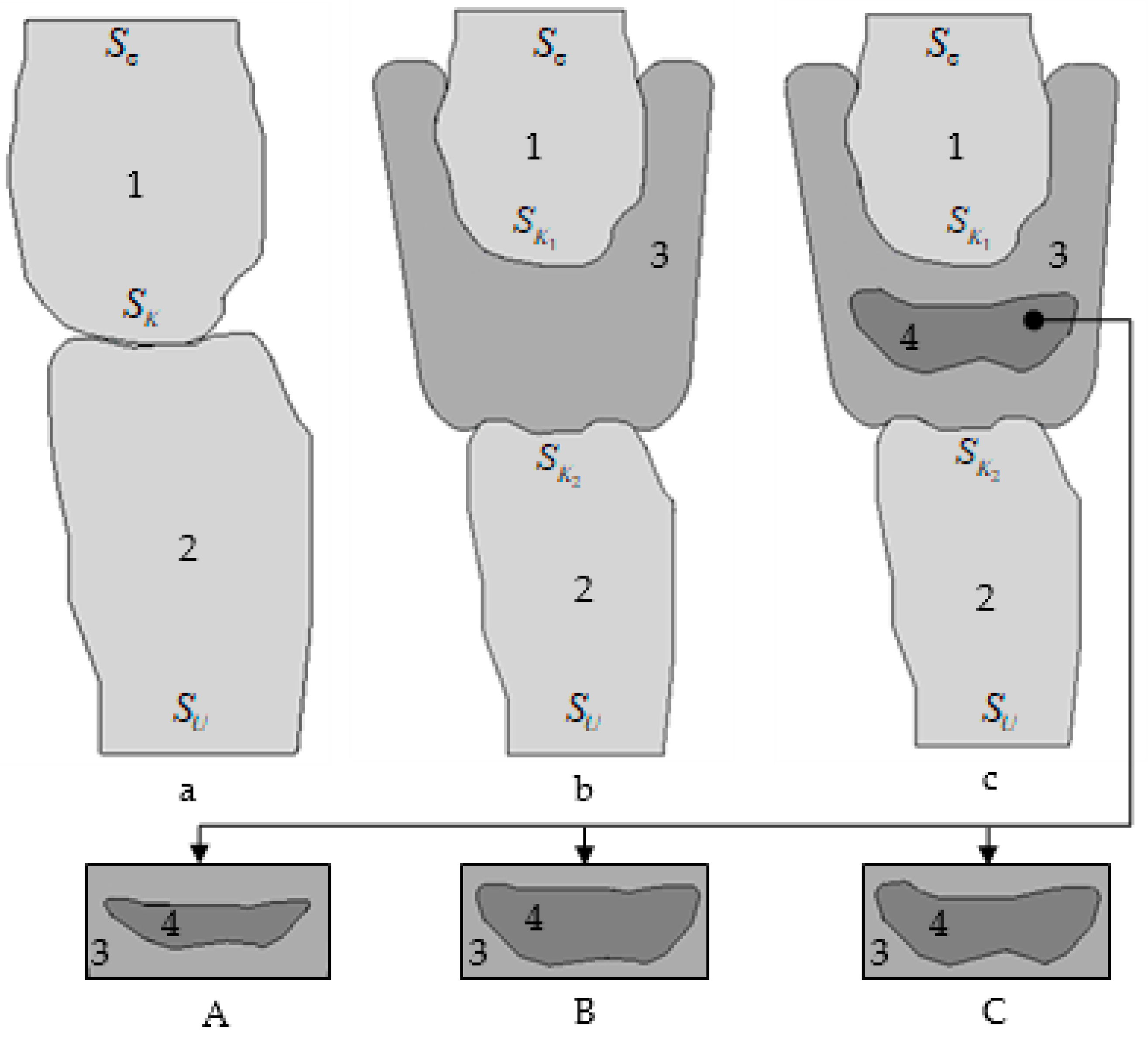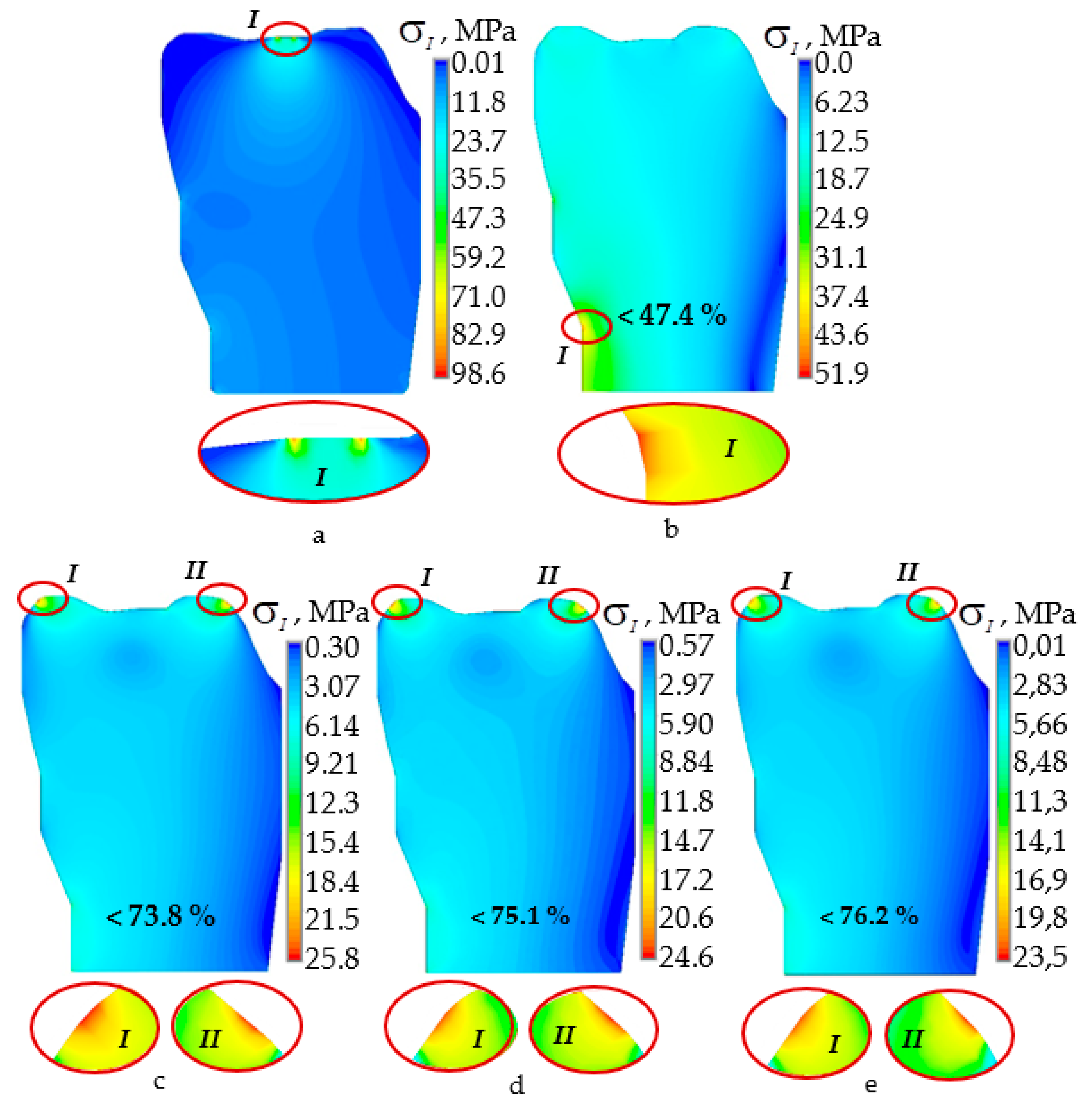Modeling the Contact Interaction of a Pair of Antagonist Teeth through Individual Protective Mouthguards of Different Geometric Configuration
Abstract
:1. Introduction
1.1. Problem Context
1.2. Research Objectives
- -
- To solve the problem of deformation of teeth during occlusion for a specific clinical case, with/without mouthguards;
- -
- To model the frictional contact in the area of teeth occlusion;
- -
- To use an elastoplastic model of behavior on the base material of the EVA mouthguards;
- -
- To model various configurations of mouthguards for a clinical case;
- -
- To analyze the influence of the geometry and thickness of the A-silicone layer on the system “mouthguard–teeth”.
1.3. Problem Description
2. Materials and Methods
2.1. Design of the Experiment
- Case c-A—the thickness of the A-silicone interlayer in the occlusion region was 1.6–1.9 mm (22.8–27.1% of the maximum thickness of the mouthguard);
- Case c-B—the thickness of the A-silicone interlayer in the occlusion region was 2.9–3.2 mm (41.4–45.7% of the maximum thickness of the mouthguard);
- Case c-C—the thickness of the A-silicone interlayer in the occlusion region was 2.2–3.2 mm (31.4–45.7% of the maximum thickness of the mouthguard).
2.2. Mechanical Properties of the Mouthguard Components
2.3. Loading and Boundary Conditions
2.4. Numerical Finite Element (FE) Solution and Convergence
3. Results
4. Discussion
4.1. Limitation Statement
- -
- Clarification of the physical, mechanical and frictional properties of the materials of the biomechanical unit;
- -
- Clarification of the models of teeth and analysis of the influence of their multilayerness and the nature of the conjugation of layers on the deformation of the biomechanical unit in flat and axisymmetric formulations;
- -
- Clarification of the level and type of loads acting on the biomechanical unit;
- -
- Transition to three-dimensional models.
4.2. Main Results
- The loose fit, which leads to the need to hold the mouthguard, difficulty breathing and distorted speech.
- Adaptation to the dentition through heating and seating is similar to taking a dental impression; this mouthguard fit on the teeth depends on the human factor, which is often not ideal.
- Fracture and creep can be observed with repeated heat treatment, as well as an increase in the hardness of materials, which leads to its early failure and a negative effect on the athlete’s body.
4.3. The Mouthguard Thickness Analysis
5. Conclusions
- -
- Mouthguards, with an additional intermediate layer of A-silicone, make it possible to reduce the level of stress intensity in the hard tissues of the teeth by 15–25% more than when using individual multilayer EVA mouthguards.
- -
- There is no pronounced localization of zones of maximum stress intensity in the hard tissues of the teeth, for all considered options for the geometry of the intermediate layer of A-silicone, when using multilayer mouthguards with an A-silicon interlayer.
- -
- The geometric configuration of the A-silicone interlayer has a significant effect on the stress–strain state of a pair of antagonist teeth and a mouthguard.
- -
- The greatest decrease in the level of deformation characteristics of the investigated unit is observed when using a mouthguard with an interlayer, adjusted to the geometry of the elements of the dentition.
Author Contributions
Funding
Institutional Review Board Statement
Informed Consent Statement
Data Availability Statement
Conflicts of Interest
References
- Prado, D.G.D.A.; Sovinski, S.R.P.; Nary, H.; Brasolotto, A.G.; Berretin-Felix, G. Oral motor control and orofacial functions in individuals with dentofacial deformity Controle motor oral e funções orofaciais em indivíduos com deformidade dentofacial. Audiol. Commun. Res. 2015, 20, 76–83. [Google Scholar] [CrossRef] [Green Version]
- Liao, Z.; Chen, J.; Zhang, Z.; Li, W.; Swain, M.; Li, Q. Computational modeling of dynamic behaviors of human teeth. J. Biomech. 2015, 48, 4214–4220. [Google Scholar] [CrossRef]
- Fedorova, N.V. The study of the stress-strain state of the dental ceramic implants depending on their shape and bone mineralization degree. Russ. J. Biomech. 2019, 23, 388–394. [Google Scholar] [CrossRef]
- Peck, C.C. Biomechanics of occlusion—Implications for oral rehabilitation. J. Oral Rehabil. 2016, 43, 205–214. [Google Scholar] [CrossRef] [PubMed]
- Carvalho, V.; Soares, P.; Verissimo, C.; Pessoa, R.; Versluis, A.; Soares, C. Mouthguard Biomechanics for Protecting Dental Implants from Impact: Experimental and Finite Element Impact Analysis. Int. J. Oral Maxillofac. Implant. 2018, 33, 335–343. [Google Scholar] [CrossRef] [Green Version]
- Mills, S.; Canal, E. Prevention of Athletic Dental Injuries: The Mouthguard. In Modern Sports Dentistry; Spring: Berlin/Heidelberg, Germany, 2018; pp. 111–133. ISBN 9783319444161. [Google Scholar]
- Tribst, J.P.M.; Dal Piva, A.M.D.O.; Borges, A.L.S.; Bottino, M.A. Simulation of mouthguard use in preventing dental injuries caused by different impacts in sports activities. Sport Sci. Health 2019, 15, 85–90. [Google Scholar] [CrossRef] [Green Version]
- Khan, S.A.; Fatima, M.; Hassan, M.; Khalid, N.; Iqbal, A.; Raja, A.A.; Annas, M. MOUTHGUARDS. Prof. Med. J. 2018, 25, 1029–1033. [Google Scholar] [CrossRef] [Green Version]
- Fasciglione, D.; Persic, R.; Pohl, Y.; Filippi, A. Dental injuries in inline skating? Level of information and prevention. Dent. Traumatol. 2007, 23, 143–148. [Google Scholar] [CrossRef]
- Westerman, B.; Stringfellow, P.M.; Eccleston, J.A. The effect on energy absorption of hard inserts in laminated EVA mouthguards. Aust. Dent. J. 2000, 45, 21–23. [Google Scholar] [CrossRef] [PubMed] [Green Version]
- Westerman, B.; Stringfellow, P.M.; Eccleston, J.A. Beneficial effects of air inclusions on the performance of ethylene vinyl acetate (EVA) mouthguard material. Br. J. Sports Med. 2002, 36, 51–53. [Google Scholar] [CrossRef] [Green Version]
- Otani, T.; Kobayashi, M.; Nozaki, K.; Gonda, T.; Maeda, Y.; Tanaka, M. Influence of mouthguards and their palatal design on the stress-State of tooth-periodontal ligament-bone complex under static loading. Dent. Traumatol. 2018, 34, 208–213. [Google Scholar] [CrossRef]
- Gialain, I.O.; Coto, N.P.; Driemeier, L.; Noritomi, P.Y.; Dias, R.B.E. A three-dimensional finite element analysis of the sports mouthguard. Dent. Traumatol. 2016, 32, 409–415. [Google Scholar] [CrossRef] [PubMed]
- Kamenskikh, A.A.; Ustjugova, T.N.; Kuchumov, A.G. Modelling of the tooth contact through one-layered mouthguard. J. Phys. Conf. Ser. 2018, 1129, 012014. [Google Scholar] [CrossRef]
- Kamenskih, A.; Ustugova, T.; Kuchumov, A.G.; Taiar, R. Numerical evaluation of sport mouthguard application. Adv. Intell. Syst. Comput. 2020, 1018, 581–585. [Google Scholar] [CrossRef]
- Lokhov, V.A.; Kuchumov, A.G.; Merzlyakov, A.F.; Astashina, N.B.; Ozhgikhina, E.S.; Tropin, V.A. Experimental investigation of materials of novel sport mouthguard design. Russ. J. Biomech. 2015, 19, 354–364. [Google Scholar] [CrossRef]
- Kerr, I.L. Mouth Guards for the Prevention of Injuries in Contact Sports. Sport. Med. 1986, 3, 415–427. [Google Scholar] [CrossRef] [PubMed]
- Ahn, H.-W.; Lee, S.-Y.; Yu, H.; Park, J.-Y.; Kim, K.-A.; Kim, S.-J. Force Distribution of a Novel Core-Reinforced Multilayered Mandibular Advancement Device. Sensors 2021, 21, 3383. [Google Scholar] [CrossRef] [PubMed]
- Kamenskikh, A. The Analysis of the Work of Materials of Mouthguard Designs during Biomechanical Deformation. Solid State Phenom. 2018, 284, 1355–1360. [Google Scholar] [CrossRef]
- Kamenskih, A.; Astashina, N.B.; Lesnikova, Y.; Sergeeva, E.; Kuchumov, A.G. Numerical and experimental study of the functional loads distribution in the dental system to evaluate the new design of the sports dental splint. Ser. Biomech. 2018, 32, 3–15. [Google Scholar]
- Kamenskikh, A.A.; Ustjugova, T.N.; Kuchumov, A.G. Comparative analysis of mechanical behavior of the tooth pair contacting with different mouthguard configurations. IOP Conf. Ser. Mater. Sci. Eng. 2019, 511, 012003. [Google Scholar] [CrossRef]
- Westerman, B.; Stringfellow, P.M.; Eccleston, J.A. EVA mouthguards: How thick should they be? Dent. Traumatol. 2002, 18, 24–27. [Google Scholar] [CrossRef]
- Bochnig, M.S.; Oh, M.J.; Nagel, T.; Ziegler, F.; Jost-Brinkmann, P.G. Comparison of the shock absorption capacities of di_erent mouthguards. Dent. Traumatol. 2017, 33, 205–213. [Google Scholar] [CrossRef] [PubMed]
- Sarac, R.; Helbig, J.; Dräger, J.; Jost-Brinkmann, P.-G. A Comparative Study of Shock Absorption Capacities of Custom Fabricated Mouthguards Using a Triangulation Sensor. Materials 2019, 12, 3535. [Google Scholar] [CrossRef] [Green Version]
- Ferrari, C.H.; Ferreira De Medeiros, J.M. Dental trauma and level of information: Mouthguard use in different contact sports. Dent. Traumatol. 2002, 18, 144–147. [Google Scholar] [CrossRef] [PubMed]
- Knapik, J.J.; Marshall, S.W.; Lee, R.B.; Darakjy, S.S.; Jones, S.B.; Mitchener, T.A.; delaCruz, G.G.; Jones, B.H. Mouthguards in Sport Activities. Sport. Med. 2007, 37, 117–144. [Google Scholar] [CrossRef]
- Sousa, A.M.; Pinho, A.C.; Messias, A.; Piedade, A.P. Present status in polymeric mouthguards. A future area for additive manufacturing? Polymers 2020, 12, 1490. [Google Scholar] [CrossRef]
- Tribst, J.P.M.; Dal Piva, A.M.D.O.; de Carvalho, P.C.K.; de Queiroz Gonçalves, P.H.P.; Borges, A.L.S.; de Arruda Paes-Junior, T.J. Does silica–nylon mesh improves the biomechanical response of custom-made mouthguards? Sport Sci. Health 2020, 16, 75–84. [Google Scholar] [CrossRef]
- Takeda, T.; Ishigami, K.; Mishima, O.; Karasawa, K.; Kurokawa, K.; Kajima, T.; Nakajima, K. Easy fabrication of a new type of mouthguard incorporating a hard insert and space and offering improved shock absorption ability. Dent. Traumatol. 2011, 27, 489–495. [Google Scholar] [CrossRef] [PubMed] [Green Version]
- Matsuda, Y.; Nakajima, K.; Saitou, M.; Katano, K.; Kanemitsu, A.; Takeda, T.; Fukuda, K. The effect of light-cured resin with a glass fiber net as an intermediate material for Hard & Space mouthguard. Dent. Traumatol. 2020, 36, 654–661. [Google Scholar] [CrossRef]







Publisher’s Note: MDPI stays neutral with regard to jurisdictional claims in published maps and institutional affiliations. |
© 2021 by the authors. Licensee MDPI, Basel, Switzerland. This article is an open access article distributed under the terms and conditions of the Creative Commons Attribution (CC BY) license (https://creativecommons.org/licenses/by/4.0/).
Share and Cite
Kamenskikh, A.; Kuchumov, A.G.; Baradina, I. Modeling the Contact Interaction of a Pair of Antagonist Teeth through Individual Protective Mouthguards of Different Geometric Configuration. Materials 2021, 14, 7331. https://doi.org/10.3390/ma14237331
Kamenskikh A, Kuchumov AG, Baradina I. Modeling the Contact Interaction of a Pair of Antagonist Teeth through Individual Protective Mouthguards of Different Geometric Configuration. Materials. 2021; 14(23):7331. https://doi.org/10.3390/ma14237331
Chicago/Turabian StyleKamenskikh, Anna, Alex G. Kuchumov, and Inessa Baradina. 2021. "Modeling the Contact Interaction of a Pair of Antagonist Teeth through Individual Protective Mouthguards of Different Geometric Configuration" Materials 14, no. 23: 7331. https://doi.org/10.3390/ma14237331
APA StyleKamenskikh, A., Kuchumov, A. G., & Baradina, I. (2021). Modeling the Contact Interaction of a Pair of Antagonist Teeth through Individual Protective Mouthguards of Different Geometric Configuration. Materials, 14(23), 7331. https://doi.org/10.3390/ma14237331






